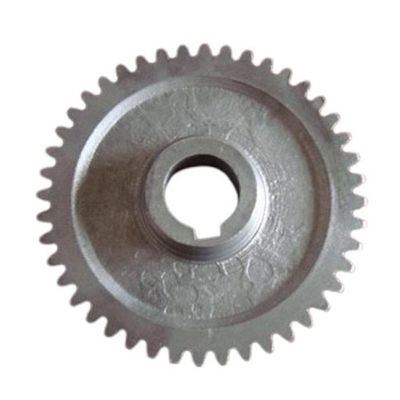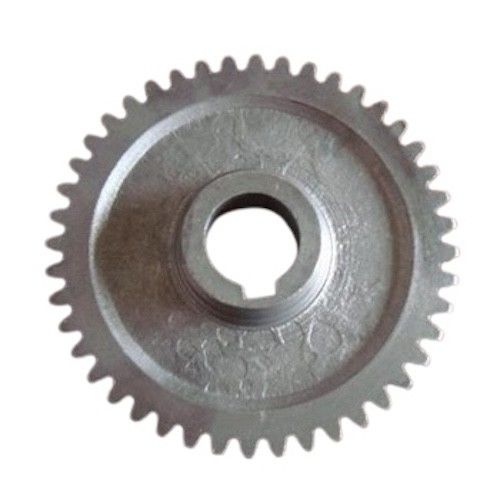Custom Iron Casting Parts Cast Iron Gear For Farming Machinery
Product Details:
| Place of Origin: | China |
| Brand Name: | Twinkle Industrial |
| Certification: | ISO 9001 |
| Model Number: | TIICP-112 |
Payment & Shipping Terms:
| Minimum Order Quantity: | 10 pcs |
|---|---|
| Price: | Negotiable |
| Packaging Details: | Non-fumigation wooden box |
| Delivery Time: | 20 work days |
| Payment Terms: | T/T, L/C |
| Supply Ability: | 20000 pc per month |
|
Detail Information |
|||
| Product Name: | OEM Cast Iron Spur Gear Casting And Machining Gear For Harvester Components | Application: | Machines |
|---|---|---|---|
| Material: | Cast Iron | Process: | Casting |
| Service: | Can Be Customized | ||
| Highlight: | Gear Iron Casting Parts,Farming Machinery Iron Casting Parts,Custom Iron Casting Parts |
||
Product Description
Custom Iron Casting Parts Cast Iron Gear For Farming Machinery
Quick Detail:
· Ductile Iron Casting Gear
· Cast iron GGG40
· Resin Sand Casting and CNC Machining
· Shot Blasting fininsh for surface treatment
· Agricultural Machinery, Machine tool, Textile machines, sewing machines, cigarette machines, spraying equipment
Product Description:
The production of cast iron gears involves several key techniques and processes. Here are the general steps involved in the production of cast iron gears:
-
Pattern Making: The first step is to create a pattern of the gear, which serves as a template for the casting process. The pattern is typically made from wood, metal, or plastic and represents the desired shape and dimensions of the gear.
-
Molding: The pattern is used to create a mold cavity into which molten iron will be poured. The mold can be made from sand, ceramic, or metal. The pattern is placed in the mold material, and the mold is carefully prepared to ensure proper filling and solidification of the molten iron.
-
Melting and Pouring: Iron, usually in the form of pig iron or scrap iron, is melted in a furnace at high temperatures. Once the iron reaches the desired temperature and is fully molten, it is poured into the prepared mold cavity. Care must be taken to ensure proper pouring techniques to minimize defects and achieve a uniform filling of the mold.
-
Solidification and Cooling: After pouring, the molten iron begins to solidify within the mold cavity. The cooling process allows the iron to solidify completely and form the desired shape of the gear. Controlled cooling rates and cooling methods help ensure the desired metallurgical properties and minimize defects.
-
Shakeout and Cleaning: Once the casting has cooled and solidified, the mold is removed, often through a process called shakeout. The cast gear is then cleaned to remove any residual mold material, such as sand or ceramic, using methods like shot blasting or sandblasting.
-
Machining: Cast iron gears often require machining to achieve the final desired shape, dimensions, and surface finish. Machining processes such as turning, milling, grinding, and drilling are employed to remove excess material and create the necessary gear tooth profile, bores, keyways, and other features.
-
Heat Treatment: Depending on the specific requirements of the gear, heat treatment may be performed to enhance its mechanical properties. Common heat treatment processes for cast iron gears include annealing, quenching, tempering, and case hardening.
-
Finishing: After machining and heat treatment, the cast iron gears undergo any necessary finishing processes, such as deburring, polishing, or coating, to improve their appearance, functionality, and durability.
It's important to note that the specific production techniques and processes can vary depending on factors such as the complexity of the gear design, the size of the gear, the desired tolerances, and the manufacturer's capabilities and preferences. Advanced foundries may employ advanced technologies and automation to optimize the casting process and ensure consistent quality.
Product Specifications:
| Commodity | Iron Casting & Machining Internal Gear |
| Standard | ASTM, DIN, JIS, EN, ISO, BS, JCSI, GB |
| Material | Grey iron (HT200,HT250,HT300), Ductile iron (QT400-18,QT400-15,QT450-10,QT500-7) |
| Unit Weight | 0,05 kg ~ 1,000 kg. |
| Tolerance | CT6-CT8 |
| Machining | Turning, Milling, Drilling, Cutting, Reaming, Threading, Welding, Tooling, etc |
| Surface Treatment | Shot blasting, Painting, Powder coating, Electroplating, Chrome plating, etc |
| Package | Standard wooden box package or as your customized package |
| Applications |
Agricultural machinery, Petroleum machinery, Mining machines, Construction, Automotive & Truck, Medical, Marine, Railway & Train, Power lines, Furniture, Lighting, Flange, Valve and Pump, Electronic, Pipeline, etc. |
| Brand | Twinkle Industrial |
![]()
![]()
Product Applications:
Widely used agricultural machinery, petroleum machinery, mining machines, construction, automotive & truck, medical, marine, railway & train, power lines, furniture, lighting, flange, valve and pump, electronic, pipeline, etc.
FAQ
Q1. How can we get a quotation?
A: Please send the parts 2D drawing (in PDF format) and 3D model in IGS or STP format together with material, production technique, purchasing qty, etc, or provide sample to us.
Q2. What about the lead time?
A: 15-20 days for Sample making ,20 working days for mass production.
Q3. Do you have any MOQ limit for casting parts?
A: It depends on different parts. For some parts, 1 pc can be acceptable.
Q4. What is your payment term?
A: Mold: 50% payment in advance, balance after the sample approval.
B: Mass production: 30% payment in advance, 70% balance before shipment.
Q5. What is your quality control process?
A: Each casting parts will be provided with raw material report ( chemical composition and physical property), and dimension measuring report before shipment.
Q6. How about the packaging?
A: Standard wooden box package or as your customized package.





